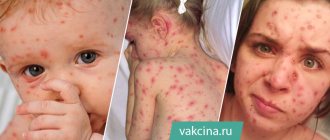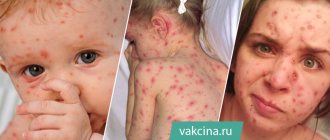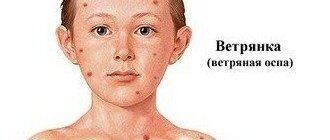Chickenpox in children is the most common disease after ARVI that parents have to deal with. The disease cannot be called dangerous, since most often it occurs in a mild form, and after recovery a stable immunity is formed. Diagnosing the pathology is not difficult, since the signs are clearly expressed.
Causes of chickenpox in children
Chickenpox is an infectious disease caused by the herpes virus type 3 Varicella Zoster (VZV). The disease spreads by airborne droplets; pathogenic microorganisms quickly die in the external environment, but can be transported with air currents over long distances. To become infected with chickenpox, you do not have to be in close contact with a sick person, just being in the same room with him is enough.
The only source of infection is the carrier of the infection; the virus is not transmitted through objects, third parties and animals. The causative agent of the disease does not tolerate high temperatures or exposure to ultraviolet radiation, so the child needs to walk more in sunny weather, but only away from other children.
Important! The contagiousness of the Zoster virus is 100%; if there is at least one sick child in a children's group, all children will get sick. It’s just that sometimes the disease manifests itself in the form of several pimples, while the temperature is normal, parents may not even notice that the baby has had chickenpox.
Smallpox
The cessation of vaccination against smallpox could provoke an increase in HIV infections . According to immunologists, the smallpox vaccine reduced the likelihood of the immunodeficiency virus entering cells. The authors of the study, American scientists from the University of California and several other research centers, described in the pages of the journal the results of experiments on cell cultures taken from people who had been vaccinated. The researchers found that in cells from people previously vaccinated against smallpox, HIV multiplied more slowly than in the same cells from people who had not been vaccinated.
Caution won't hurt, however . One should not, however, assume that the smallpox vaccine protects against HIV and immediately run to get vaccinated: scientists emphasize that the experiment was carried out on a cell culture, and not on a whole organism, and a five-fold reduction in the rate of spread of the virus was not obtained for every variety HIV, but only for certain strains. These strains are quite common and play an important role in the development of the epidemic, but they are far from the only ones. And slowing down the spread of the virus by five times is still not equivalent to its complete destruction.
Another thing is that until the 1970s, when smallpox vaccinations were administered en masse, the risk of infection could be less, and for a long time the virus simply could not spread beyond a limited area in Central Africa. Even now, the probability of HIV transmission through sexual contact does not exceed tenths of a percent, and a decrease in this value by several times, coupled with poor development of transport, could well prevent the pandemic from spreading. Now that the number of carriers of the virus is about 40 million people worldwide, there is no hope of eradicating HIV, even if the results of preliminary experiments are fully confirmed. But any promising approach to reducing the risk of transmission of the virus is certainly worth considering.
How it works? A key role in the potential protective mechanism is played by receptors such as CCR5 - protein molecules located inside the cell membrane. It is these molecules that HIV interacts with when entering a cell, and virologists know that people with a mutant form of CCR5 receptors for HIV are much less vulnerable.
Windows and doors
CCR5 is not the only molecule that the virus uses to enter cells. Equally important are the CD4 receptors. Using an analogy, we can compare receptors to the “windows” and “doors” of a cell. Burglars enter through both doors and windows, so installing safety glass or secure locks separately only reduces, but does not eliminate, the risk of theft.
By the way, the analogy between receptors and windows is also noteworthy in that the cell itself needs receptors for selective interaction with other cells.
The vaccinia virus, which is the basis of the vaccine (the similarity in the names is not accidental; the virus is named precisely for its noble function) against smallpox, can change the expression of the CCR5 gene. This means that the gene responsible for the synthesis of receptor proteins can be “turned off,” and over time, the CCR5 receptors simply disappear in a vaccinated patient.
How exactly this happens, how long the effect lasts (scientists conducted experiments on cells from people vaccinated three and six months before the experiment) and whether it can also be enhanced is still unclear. But what is clear is that smallpox vaccinations are safe enough for mass use: they were given to every child on the planet at one time, and many were left with a tiny scar on their shoulder.
Only in the 1980s, when smallpox disappeared from the face of the Earth and remained only in a few microbiological laboratories, vaccinations were abandoned, since the risk of side effects began to many times exceed the risk of contracting smallpox itself. But if it is proven that smallpox vaccinations also help against HIV (even if not absolutely), it will not be difficult to return to smallpox vaccination.
Stages and symptoms of chickenpox in a child
The average incubation period for chickenpox is 10–21 days; a person is considered infectious 24 hours before the rash appears and for 5 days after the last pimple disappears.
After infection, the chickenpox virus penetrates the mucous membranes of the respiratory system, begins to actively multiply, enters the general bloodstream, and affects the epithelial layer of the skin, but at the initial stage it is impossible to determine the disease. Symptoms of the disease depend on the period of pathology.
How does chickenpox manifest at different stages?
| Period | Duration | Symptoms |
| Incubation | The early stage begins from the moment the virus enters the body and lasts up to 3 weeks | At the beginning of the disease, there are no symptoms of chickenpox, the child feels normal. |
| Premonitory | 1–2 days | The first nonspecific signs appear - fever, poor appetite, chills, excessive sweating, weakness, and sometimes vomiting. Some children do not have this stage of the disease. |
| Period of rash | 3–5 days, the appearance of rashes has a wave-like character. | The temperature can rise to 39 degrees or more. Nature of the rash: 1. On the first day of the rash period, flat red spots with clear edges appear on the body. 2. After a few hours, instead of a stain, bubbles with transparent liquid contents inside form. 3. Gradually, the bubbles burst and become covered with a crust, which falls off on its own. |
To understand what a rash looks like, you need to look at a photo of a sick child.
At the initial stage, rashes appear on the face, cover the stomach and back, then the vesicles spread not only to all parts of the body, but also to the mucous membranes of the throat, mouth, tongue, and genitals, while never affecting the palms and soles.
What are smallpox, pockmarks, cowpox and blackpox in humans?
black pox virus in the photo
Pockmarks are single formations of the smallpox virus, which have a rounded shape and in appearance resemble an inflamed pimple that rises above the general skin cover. Smallpox and smallpox are actually the same dermatological disease, the distinctive characteristics of which consist only in the genotype of the microorganism that causes the disease.
The smallpox virus or smallpox virus covers the entire skin of an infected person with pockmarks. The epithelium acquires a rich black tint, which creates a visual effect as if the patient’s skin color has changed from natural pink to brown.
Both smallpox and smallpox belong to the group of dangerous viral infections that are included in the list of the World Health Organization as posing a threat to the lives of the population of planet Earth. Without exception, all people who have not previously received vaccination and do not have acquired immunity are susceptible to this disease. It is transmitted from an infected person to a healthy person by airborne droplets, or as a result of contact with skin or an infected object. The virus is most widespread in the regions of Southeast Asia and throughout Africa. A patient with smallpox is a source of infection at all stages of the disease.
Cowpox is a viral disease that is transmitted from cattle to humans. The disease is characterized by a general toxic effect on the body of the infected person. Unlike black and natural, the cow strain does not manifest itself in the form of multiple pockmarks on the patient’s body, but only as a single formation. Cowpox appears on a person's hands. In some cases, pockmarks form on the face. Most often, people who care for livestock become infected with the smallpox virus of this genotype. The viral infection is transmitted as a result of tactile contact of the surface of the human body with the skin of a cow.
Field mice, cats and foxes can also be carriers of the disease.
The fact of transmission of the cowpox virus from person to person has not been recorded in medical practice.
Types and forms of the disease
In children, chickenpox occurs in a typical and atypical form; based on the symptoms, there are mild or latent, moderate and severe forms of the pathology.
Forms of the disease:
- mild – temperature values are normal or no more than 38 degrees, the period of rashes lasts no more than 4 days, the rashes are few in number, the general condition is satisfactory;
- moderate - intoxication is characterized by headache, aching in the lower back, muscles, fatigue, temperature readings above 38 °, numerous rashes appear over 5 days;
- severe - frequent vomiting, lack of appetite, temperature rises to 40 degrees, the period of rash lasts 9 days, the rash covers the entire body and mucous membranes.
Chickenpox is congenital - the child becomes infected in utero from the mother. If infection occurs in the early stages, children are born with various anomalies or deformities; if a woman is diagnosed with chickenpox in the later stages, the baby will be born with antibodies to chickenpox, without signs of pathology.
Chickenpox of newborns - develops if a woman becomes infected with the Zoster virus 5 days before giving birth, or within a few days after the birth of the child. The baby is born with typical signs of chickenpox; the pathology is easily treated with antiherpes drugs. But if therapy is not started in a timely manner, the mortality rate is more than 30%.
Turkish chickenpox got its name because its symptoms are similar to ordinary chickenpox, but the disease is caused by the Coxsackie enterovirus. The pathology manifests itself in the form of high fever, abscesses and ulcers in the mouth, on the buttocks, limbs, genitals, vomiting and intestinal upset. The incubation period is 3–10 days, immunity is not developed after recovery.
Sometimes children are diagnosed with false chickenpox - this is when an allergy occurs like chickenpox.
Types of atypical chickenpox
Gangrenous - the virus affects the deep layers of the skin, the cells gradually die, and necrosis develops a few days after the first rash appears. A characteristic sign is a dark purple rim around the papules; ichor accumulates in the blisters.
When the blisters open, they are covered with a scab; under the crust there is an ulcer that does not heal well. Gangrenous chickenpox occurs against a background of high temperature, severe intoxication, and the virus affects the nervous system. This type occurs in weakened children with various types of immunodeficiency, and often ends in death.
Bullous chickenpox - instead of a small rash, large blisters with a flabby surface and pale yellow liquid inside appear on the skin. After opening the bullae, long-term non-healing ulcers and deep wounds with a fibrin bottom appear.
Generalized chickenpox - the virus affects all internal organs; without timely and correct treatment, there is a high probability of death of the child. The pathology is rare, most often it is diagnosed in children with severe defects in the immune system, during long-term treatment with steroid or antitumor drugs.
The hemorrhagic form of chickenpox - blood accumulates in the blisters, blood clotting worsens, which causes nasal and internal bleeding, and the gums bleed heavily. Dark red crusts form in place of the papules; after recovery, deep scars and scars remain on the skin. The disease develops in patients with disorders of the hematopoietic system.
The rudimentary form is the safest type of chickenpox; it often occurs in an erased form, without a rash or with minor rashes in the form of spots, the temperature remains within normal limits. Diagnosed in infants in the first months of life, or in vaccinated children.
Important! After recovery, children develop stable, but not lifelong, immunity, so secondary chickenpox is often diagnosed in adolescence or adulthood.
Treatment of smallpox in humans
In developed countries, where the population receives vaccinations in childhood, outbreaks of smallpox virus practically do not occur. If, nevertheless, the fact of infection with smallpox or smallpox is revealed, then the patient is administered antiviral drugs intramuscularly and intravenously. The main drug that can successfully resist this viral infection is Metisazone. It is injected 2 times a day for 5-6 days. Also, a special anti-spine immunoglobulin, 5 ml, is administered intramuscularly. In order to avoid the addition of a secondary infection to ulcerative formations on the skin, the affected areas of the epithelium are treated with external agents.
It is recommended to use salicylic-zinc ointment, brilliant green solution, iodine, hydrogen peroxide with a concentration of no more than 3%.
If a bacterial infection gets into the wounds and secondary inflammation develops, broad-spectrum antibiotics are used. This group includes semisynthetic penicillins, intramuscular injections of drugs of the cephalosporin group, and macrolides. At all stages of treatment, doctors monitor the biochemical composition of the patient’s blood. In order for it to be maintained at a stable level, manipulations are carried out to neutralize toxins. For this purpose, blood is purified with physiological solutions, as well as sorbent preparations - Enterosgel, activated carbon, Atoxil, Smecta.
Diagnostics
It is not difficult to recognize typical chickenpox after a thorough physical examination, since the disease has a classic clinical picture. The atypical form can be confused with herpes simplex, bullous dermatosis, eczema, congenital syphilis, pyoderma; laboratory tests will help differentiate chickenpox from other infections.
What tests need to be taken:
- clinical blood test to determine the level of ESR;
- microscopic examination of fluid from vesicles;
- blood chemistry;
- serological tests - RSK, RTGA.
In severe cases of the disease, a general urine test, ultrasound of the abdominal organs, CT scan of the brain, and electrocardiogram are additionally prescribed to identify which organs have been affected by the virus.
Treatment of chickenpox in children
Sluggish or asymptomatic chickenpox does not require special treatment; therapy is aimed at eliminating unpleasant symptoms; for a speedy recovery, you must adhere to the drinking regime and diet.
First aid
At the first stage of the disease, the temperature may rise; if the readings are above 38.5 degrees, it is necessary to give the child an antipyretic. The main problem with chickenpox is severe itching, to avoid scratching, you need to cut your nails short, infants should wear protective anti-scratch pads, and wipe the affected areas with a weak soda solution - 1 hour. l. soda per 250 ml of water. All other medications will be prescribed by the doctor after examination and diagnosis.
Medicines
There are no specific drugs against chickenpox; medications help fight the manifestations of the disease and reduce the risk of complications.
How to treat:
- antiherpetic drugs – Acyclovir;
- antipyretics - only Ibuprofen and Paracetamol, reduce temperature, eliminate signs of the inflammatory process;
- anti-inflammatory sprays - Tantum Verde, Hexoral, prescribed for viral infection of the throat mucosa, Turkish chickenpox;
- dental gels - Kalgel, Kamistad, promote the healing of ulcers in the oral cavity;
- antihistamines in the form of tablets, drops - Erius, Fenistil;
- sorbents – Polysorb, Smecta, eliminate manifestations of intoxication;
- homeopathic remedies – Flacozide, Allizarin, Helepin.
Aspirin is contraindicated for the treatment of children; for chickenpox, acetylsalicylic acid is especially dangerous - the combination of the virus and the drug can lead to severe liver pathologies.
General recommendations
If you have chickenpox, it is necessary to avoid excessive sweating - limit the child's activity, but it is not necessary to observe strict bed rest. Clothing should be spacious, made of light natural materials, the room should always be fresh and cool, bed linen should be changed every day.
Lack of appetite is a normal phenomenon in viral diseases; there is no need to force feed sick children. If everything is fine with your appetite, the basis of your diet should be light dietary dishes in liquid or ground form. It is strictly prohibited to consume salty, fried, fatty foods, carbonated drinks, and junk food.
Drinking plenty of fluids promotes a speedy recovery, since the body will quickly cleanse itself of toxic waste from viruses. You can drink plain and mineral water, fruit drinks, rosehip infusion, chamomile, and natural juices.
Possible consequences and complications
The negative consequences of chickenpox in children are rarely diagnosed; most often, dermatological purulent complications occur - abscess, phlegmon, boils, which leave scars. If the disease is severe, the virus affects internal organs and dangerous concomitant diseases develop.
Possible consequences of chickenpox:
- Encephalitis - pathology manifests itself 7–12 days after the onset of the disease, characterized by frequent convulsions, severe headache, and impaired consciousness. In rare cases, idiocy develops.
- Myocarditis - the virus provokes the development of an inflammatory process in the heart muscle, shortness of breath occurs, the pulse rate is disturbed, and the child may complain of chest pain.
- Pneumonia – occurs in infants with neonatal chickenpox; the condition is dangerous and can be fatal.
- Nephritis is an inflammation of the kidneys that develops 10 days after the first signs of pathology appear; the disease goes away on its own and no specific treatment is required.
Since the virus can penetrate all tissues and mucous membranes, the consequences of chickenpox can be blurred vision, damage to the mucous membranes of the eyes, hepatitis, problems with the pancreas and spleen.
Possible complications
Negative consequences after infection and complete recovery from chickenpox can develop only if the patient did not seek medical help in a timely manner, or the patient had a confluent form of this viral disease. In this case, a person may experience the following irreversible processes in the body, namely:
- fulminant sepsis with infectious damage to all tissues of most vital organs and blood;
- inflammation of the cerebral cortex with changes in the cellular structure of the gray matter;
- bilateral granulosa pneumonia of infectious etiology;
- multiple hemorrhages in the subcutaneous layer, which later become the basis for the formation of blood clots;
- damage to the central nervous system, which is expressed in impaired coordination of movements, inadequate response to external stimuli;
- complete loss of vision;
- destruction of the immune system by the destruction of cells that perform a protective function by the virus.
In 40% of cases with the confluent form of smallpox, death occurs even before the characteristic rash forms on the person’s body. Until now, doctors cannot give a definite answer why some patients tolerate the smallpox or smallpox virus satisfactorily, while others are exposed to the confluent form of this disease with many serious consequences.
Prevention
{banner_banstat9}
It is almost impossible for a child to avoid infection with chickenpox, since he is constantly in contact with other people. The main method of prevention is strengthening the body’s protective functions and observing hygiene rules.
Important! Vaccination against chickenpox is not included in the list of mandatory vaccines for children; parents can vaccinate with Okavax and Varilrix for a fee - the average cost of the procedure is 2.5–4.5 thousand rubles.
Dr. Komarovsky about chickenpox in children
Chickenpox is a common childhood disease; if a child attends a preschool institution, he will become infected with this disease with almost 100%. The disease in children is mild; complications most often arise due to improper actions of parents.
What to do for chickenpox in children - recommendations from Dr. Komarovsky:
- Children do not need antibiotics for chickenpox - it is a viral disease.
- Zelenka and Fukortsin do not have any therapeutic effect; they can only increase the itching. These products are used as an indicator - if there are no unsmeared pimples on the skin in the morning, after 5 days the child will be non-infectious.
- Pediatricians in European countries believe that children with chickenpox become non-contagious as soon as all the burst blisters become covered with a crust, this happens approximately on the 7th–8th day of the disease. Therefore, no means are used to lubricate the rash.
- Often, parents begin to smear the child’s itchy skin with ointments with an antihistamine effect, but the active ingredients penetrate into the blood through the wounds, which is dangerous for an overdose. Antihistamines can be given to children only in tablets, strictly following the instructions.
- You can bathe children with chickenpox - a cool bath with a small amount of soda relieves itching. The procedure can be carried out every 3-4 hours, do not wipe the skin, but lightly blot it.
- If the room is hot, children sweat a lot, which causes increased itching. Cool and moist air in the room is one of the effective methods of treating chickenpox in children.
- With chickenpox, children do not need bed rest; the patient should be fed light and liquid food on demand, but they need to drink a lot and often.
Antiviral drugs, interferons also do not help much; the antiherpes drug Acyclovir is prescribed only to small children under one year old, adolescents, and in severe cases of the disease. When taking Acyclovir, it is necessary to give the child more to drink; due to dehydration during drug therapy, severe kidney diseases occur.
Chickenpox is a common childhood disease; in children aged 2–7 years, it usually resolves easily, without any complications. But the older the child gets, the more severely he suffers from the disease; regular strengthening of the immune system will help to avoid negative consequences. If the parents felt very bad when they had chickenpox in childhood, then the baby also has an increased susceptibility to the chickenpox virus, in such cases it is better to get vaccinated.









